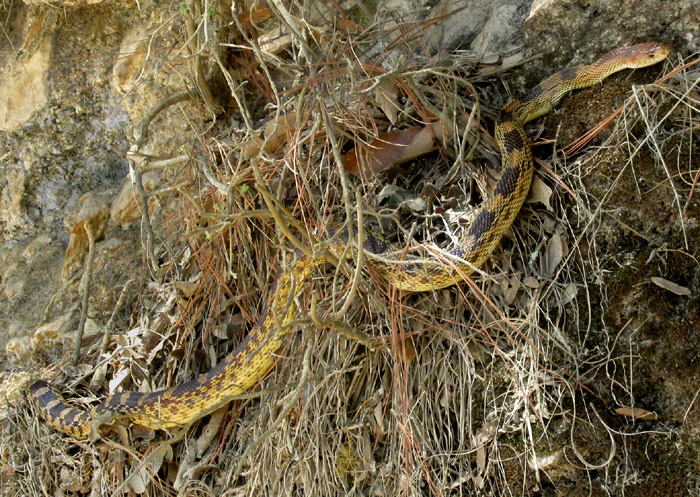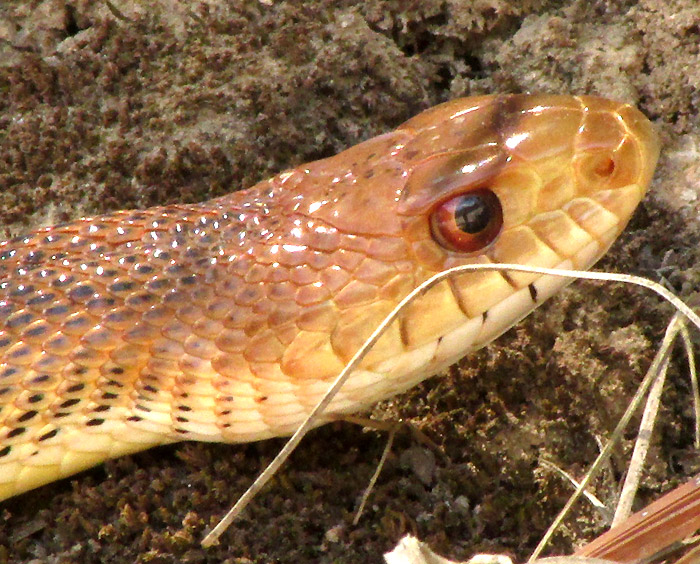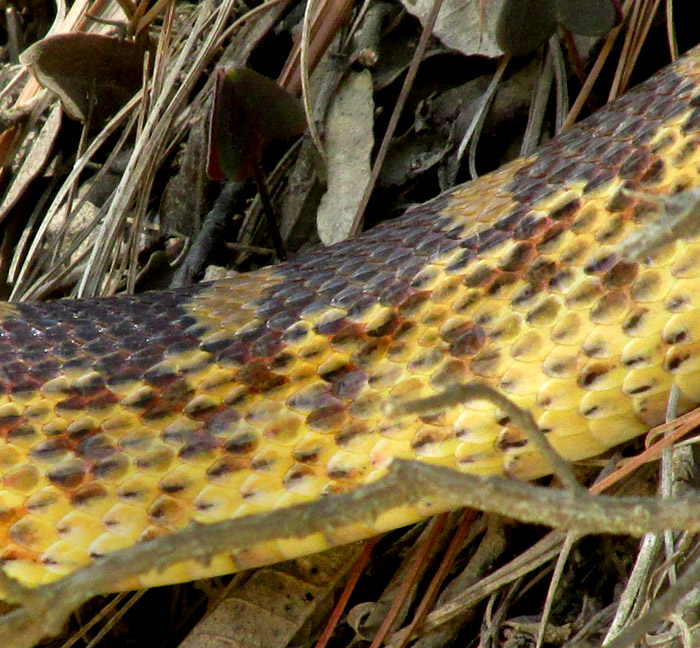Excerpts from Jim Conrad's
Naturalist Newsletter
Entry from field notes dated September 1, 2023, taken in Los Mármoles National Park in the Eastern Sierra Madre mountains, Hidalgo state, MÉXICO; near fork in road leading to Puerto de Piedra, on road between town of Trancas {on maps designated "Morelos (Trancas)"} and Nicolás Flores; oak/pine forest on limestone bedrock; elevation ~2,300m (~7,550ft); ~N20.80°, ~W99.24°
MEXICAN BULLSNAKE

On the wall of an old roadcut the above snake froze as I hiked by, and never moved as I photographed. This one wasn't as evasive as most snakes, or maybe there was a fear of falling from the exposed, near-vertical face. The body length was about as long as a medium adult's leg, and the colors gave the impression of being faded and somewhat glossy.

For identification purposes, the above view was critical, for it shows the exact arrangement of head scales -- the "pholidosis." In snake identification, each head scale has a name, and the pholodosis better than anything distinguish the species, for scale configuration varies from genus to genus, but only slightly within the species if there's geographical variation. Colors and markings are useful but often not dependable. If you don't have technical descriptions and identification keys, first the general kind of snake can be discovered by doing image searches on the Internet. Once the search is narrowed to a cluster of similar species, scales point the way. Often a view of body scales also is important:

Above it's seen that individual scales bear a very slender ridge, or keel, running their lengths. Notice that the body's top is somewhat flattened and vaguely squared where meeting the sides. Squared edges help snakes move through tangles and climb into bushes and trees.
Using the image-search-and-pholodosis approach, features seen in the above photos reveal that our snake is PITUOPHIS DEPPEI, usually known in English as the Mexican Bullsnake, though sometimes as the Mexican Pine Snake. The species is endemic just to the uplands of a large part of central Mexico, including the Eastern and Western Sierra Madres, and northern grasslands into Puebla state beyond the Trans-Mexican Volcanic Belt to our south. Within that area it's fairly common in various habitats from oak-pine forest and scrub, grasslands and even towns.
Having confidence in our snake's identification wouldn't have been possible without the fine 2020 study by Beat Schätti and others entitled "Pituophis deppei (Duméril, Bibron & Duméril, 1854) or a reassessment of Mexican bullsnakes (Reptilia: Squamata: Colubridae)." That's because similar species exist and the history of our snake's taxonomic classification is a messy one hard to untangle. There's the lookalike Pituiphis catenfifer of western North America and northern Mexico southward to almost here, sometimes in the contact zone intergrading with our species. And there's Pituiphis lineaticollis south of here, into Guatemala. These species are variable and divided into subspecies. Taxonomically, the problem has been confused by certain names being published for collections comprising more than one species, and older collections in which the collection locations are uncertain, even which continent.
At first I was hesitant about the identification because in our picture of head scales, the parallelogram-shaped scale midway the nostril and eye -- the loreal scale -- departs in shape and size from those illustrated in the study. However, the study emphasizes that the species comprises numerous geographical phenotypes -- individuals in certain regions varying in certain small ways from those in other regions.
Mexican Bullsnakes are known to feed mainly on rodents, but also other small mammals and birds. They're described as secretive, and it's said that they actively defend themselves and bite when approached. Of course they are a nonvenomous species, despite their general patterning suggesting that of certain rattlesnake species. However, the pupils of our bullsnake's eyes were round, not cat-eyed elliptic as in rattlesnakes, plus rattlesnake bodies, especially the backs of the heads, are proportionally thicker. You might compare our slender snake with that of North America's Western Rattler.